What Is Pickleball And Why Is It Over-taking Tennis?
I’ve been playing pickleball for over six years but the game is actually over 50 years old. Despite its long history, new people are asking every year “what is pickleball?”
Pickleball is the fastest growing sport in the US for over a decade and is now played in all 50 states. It combines the best elements from various racquet sports and was designed to allow for all players regardless of age or skill level to play for fun or competitively.
Pickleball courts are popping up everywhere around the country. In fact, the USAPA estimates that there are now over 9,000 places to play across the US. Over the last 10 years or so, it’s gone from being an “old person’s” game to a game of all ages that can bring family and friends together.
Pickleball is bringing loads of people to parks across the country and is even replacing tennis courts in various locations. In fact, the game is thought to have well over 5 million players now in the US alone as of 2022.
Pickleball was once primarily a game played by older, retired people looking to stay active or get in shape. Now however, the game is being recognized by all ages and being played more competitively than ever by a crowd that is in their 30s and younger.
Tournaments now draw over 2,000 participants with prize money exceeding $80k!
In short, pickleball – the game with the silly name has a serious fan base and continues to grow like a weed across the unites states with no real sign of slowing down. Even a pandemic hasn’t slowed its growth in popularity.
Keep reading to learn more about pickleball, the basics behind its rules, who can play it, and what you need to get started.
Why Is Pickleball So Popular?
Pickleball has been enormously popular for over ten years running because it is a remarkably addictive sport that is designed to be inclusive and social but competitive all at the same time. No other racket or paddle sport brings people together like pickleball does.
Not even tennis.
Pickleball takes all the feel-good elements from various paddle sports and combines them with some new rules and unique nuances. Then it mixes it all together in the most delicious of ways.
Where some sports like ping pong, racquetball, or tennis fail, pickleball excels. All while being a game that is inherently social and friendly. It’s the goldilocks of paddle sports. It’s just right.
It is this social aspect that is woven into its DNA that makes pickleball so popular and addictive. Once you get a taste, you’re going to want more.
Trust me, I took a bite six years ago and haven’t stopped playing since. In fact, this blog is a result of that obsession.
Who Is Pickleball For?
Pickleball can be played by anyone regardless of skill level, racquet sport background, or age. From a recreational standpoint, pickleball can be played by truly anyone. It is that diverse. There is even a league for wheelchair-bound players.
So, to say that pickleball is an accommodating sport would be a massive understatement.
If you were to follow me to my local court, you’d see families playing together. You’d see young adults in their 20s and 30s going against retired folks in their 50s and 60s.
In fact, the USAPA says that despite 50 to 60-year-olds making up over 20% of players in the US, 30 to 40-year-olds are right behind them at 17% and climbing.
I’m in my 40s and I’ve gone up against a 79 year old. And lost.
So the game of pickleball truly knows no age limit. And its rules are built to even the playing field. This allows for older, less athletic players who possess touch and precision to go up against and even beat younger, more athletic players half their age.
But like I said, even though older people play it, and account for a large reason for its original growth, the current trend of popularity is being driven by a younger crowd who are falling in love with pickleball’s demanding need for finesse and touch while allowing for power and authority at just the right times.
Now, let’s learn the basics on how it’s played.

How To Play – The Basics
Pickleball is played either singles or doubles but is more commonly played in a doubles format.
A game starts with the serving team winning the coin flip. Or in more casual play, one side may just let the other side serve.
The serve always starts with the player on the right-hand side serving quadrant and the serve is diagonal; just like in tennis.
The serve must be done underhand. It cannot be bounced. However, the serve in pickleball can be dropped. There is a difference between bouncing the ball and dropping the ball…more on that below when we talk rules.
The serve must cross the non-volley zone line on the opposite diagonal side of the court and the receiving team must let the serve bounce once. From there, the return of serve must also bounce, meaning the serving team cannot hit the ball out of the air yet. This is called the two-bounce rule.
After the ball has been allowed to bounce once on each team’s side of the court, the player may hit volleys or groundstrokes anywhere on the court beyond the no-volley zone.
The no-volley zone area or “kitchen” as it’s called, is the seven feet of court that runs from the no-volley zone line (or kitchen line) to the net. That space between the net and the kitchen line may only be entered if the ball has bounced in the kitchen area. Otherwise, all players must stand at the kitchen line and hit either volleys or groundstrokes.
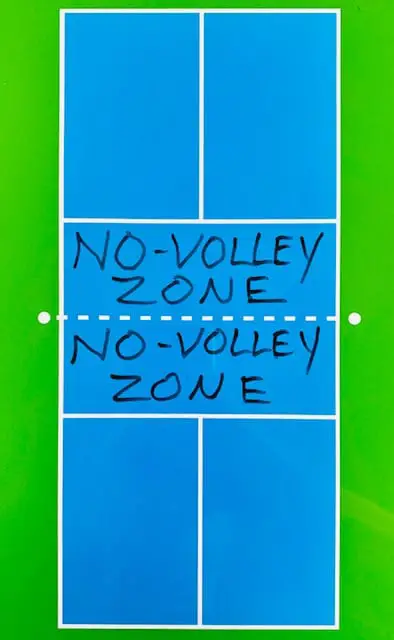
For more on why its called the “the kitchen”, click here.
From here, points are awarded to the serving team only. Points are awarded when a fault has occurred.
Faults in pickleball consist of:
-Hitting the ball out of bounds
-Hitting the ball into the net
-Not letting the serve bounce once
-Not letting the return of serve bounce once
-Any shot that is allowed to bounce more than once
-Hitting a volley while standing in the kitchen area
-Coming in contact with the kitchen line after hitting a volley
The serving team continues to serve until a fault occurs from the serving team. At this point, the serve goes to the server’s partner. In singles pickleball, the serve goes to the opponent.
From here, if the second server losses the point, then the serve goes to the return team and they each get a turn to win a point.
In pickleball, you’re either winning points as the serving team or earning the serve back as the return team.
***There are also two important things to keep in mind when playing pickleball:
- There are no “lets” on the serve. If it hits the net and lands in, it’s live. If it hits the net and lands out. The serve is lost.
- Even though in doubles play, each teammate gets a chance to serve that is NOT the case at the very start of the game. The serving team is only allowed one teammate to serve until the serve goes to the other team. Once they get the serve back however, both teammates are allowed a chance to serve.
So, when the game starts, it’s technically the serving team’s “second” server. I’ll explain further when I touch on scoring and calling the score below.
Basics For Scoring
Scoring in pickleball is relatively simple and its rules for awarding points were adopted from badminton.
Pickleball games are usually scored to 11 except in some tournament level play, games are played to 15 or 21.
Most recreational play is scored to 11, but you must win by two. So for example, if the score is 10 serving 10, the winning team must get to 12.
As I mentioned above, only the serving team earns points. If the return team wins the rally, the servers’ partner gets a turn (except to start the game). If the return team wins a second rally, they are then awarded the serve with a chance to earn points.
Calling the score is an extremely important part to pickleball. Before each serve, it is common pickleball etiquette to say the score nice and loud for everyone to hear. And you must announce the score properly.
How do you announce the score in pickleball? Announcing the score starts with the serving team’s points, then the receiving team’s points; then the number 1 or 2 signifying 1st server or 2nd server.
Here’s an example.
If I’m serving and my team has 8 points and the other team has 3 points and I’m the first server I’d call the score:
“8 – 3 – 1”
8 points, to 3 points, first server.
If my partner had already served and it was my turn to serve I’d call the score:
“8 – 3 – 2”
This means is 8 points to 3 points, second server.
Keep in mind that to start every game, whichever teammate is serving, they are technically the second server. This only happens at the start of the game. From that point on, each teammate gets a chance to serve.
Basic Pickleball Rules
The goal of each point in pickleball is to keep the ball in play by hitting it back over the net. The rules of pickleball state that a rally is won or lost based on when one of the following rules has been broken.
- The ball is hit out of bounds
- The ball lands in the net
- The ball is allowed to bounce twice
- The two-bounce rule is not upheld (the serve and/or return are not allowed to bounce)
- When someone volleys in the non-volley zone area or “kitchen”
Points are either awarded or serves are lost when one of these 5 rules or faults occurs.
Click here for my beginners guide on the most common rules in pickleball.
The Court and The Net
Pickleball is played on a court that is 20 feet wide by 44 feet long with a net that is 3” lower than a tennis net.
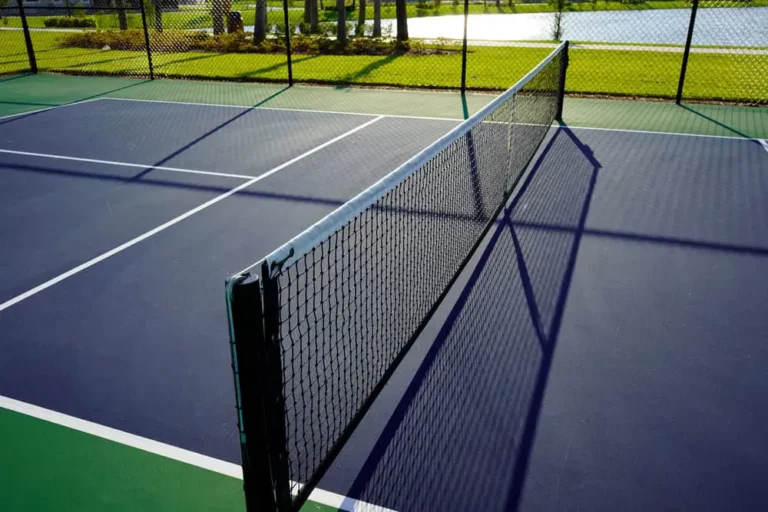
Although pickleball is commonly played on a tennis court, an actual dedicated pickleball court is much smaller than a tennis court.
Where tennis courts are 78 feet by 27 feet, a pickleball court is much smaller in scale. Stand-alone pickleball courts span 44 feet long by 20 feet wide and don’t have separate doubles lines; like in tennis.
In pickleball, the game is played on the same lines regardless of whether you’re playing singles or doubles.
And technically speaking, a tennis net is higher than a pickleball net, both at the posts and down the middle. Tennis is played with the net 42 inches high at the posts and 36 inches down the middle. But in pickleball, the net is 36 inches at the posts and 34 inches down in the middle.
But rest assured, pickleball can be comfortably played on just about any tennis court.
How Is A Pickleball Court Different Than A Badminton Court?
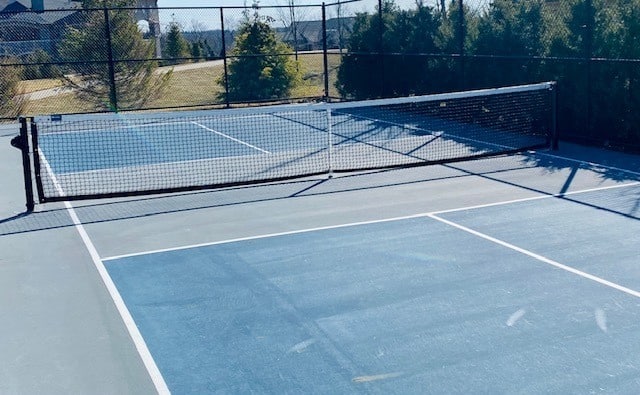
As I said above, pickleball is played on a court similar in size to a badminton court. Actually, the overall dimensions are exactly the same – 44 feet long by 20 feet wide. In fact, pickleball was born on an old, beat up badminton court in the backyard of Joel Pritchard on Bainbridge Island Washington.
But there are some fundamental differences between a pickleball court and a badminton court. Firstly, despite the same overall dimensions, a pickleball court does not have separate lines for singles and doubles like badminton does. Pickleball is played on the same size court regardless of singles or doubles.
In fact, in doubles badminton, the service line is moved up. It’s shorter. And out of bounds lines are wider than in singles. All of this is NOT the same for pickleball.
In my opinion, this makes pickleball much easier to just pick up and play.
Another key difference between a pickleball court and a badminton court is pickleball’s “no-volley zone line.” Although badminton has a similar looking line on it’s court called the “short service line” it’s actually six and a half feet from the net where pickleball’s “no-volley zone line” is 7 feet from the net.
Both lines serve as a marker on the court that the serve must go beyond but in pickleball, it also serves another purpose. The no-volley zone line indicates an area on the court called the “kitchen” and this is the seven feet of court leading up to the net that can only be stepped into after the ball has bounced.
To step into the kitchen, the ball must bounce first. It’s a “ground stroke only” area on the court. Badminton and other racket or paddle sports simply do not have this.
Fun Fact: Because pickleball was born on a badminton court, the no-volley zone line started out at six and half feet but slowly began to inch outward as the game’s rules were finalized over the course of its first year.
If you’re curious about where pickleball originated and how it’s become the fastest growing sport, read the fascinating timeline of pickleball’s growth here.
Recommended Equipment – Paddles, Balls And Shoes
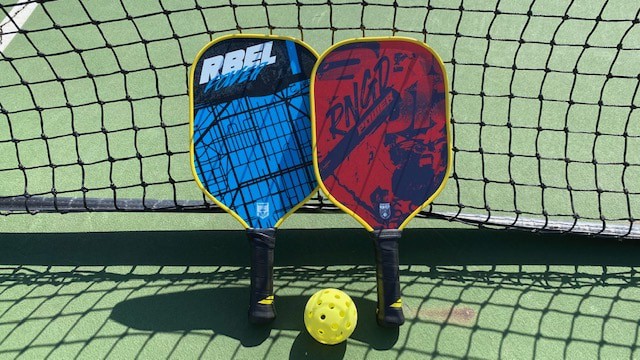
Pickleball equipment and apparel has exploded in the past five years! The sheer number of paddle options available is ridiculous!
For example, eight years ago we only had one major tennis brand manufacturing pickleball paddles. Now, however, all of them do!
So where do you start? What equipment do you need to play pickleball?
Despite the number of choices available what you need to play pickleball really comes down to three pieces of equipment:
1. A Paddle
2. Some pickleball balls (either indoor or outdoor)
3. Some quality court shoes
The Paddle
Beginner paddles can range from cheap paddle sets made in China for $30 to expensive paddles going for $200!
If you’re just starting out, there is no need to spend two hundred dollars on a paddle. If you’re playing as a couple, and want an affordable but dependable paddle set to start with, I recommend this one from Rally.
If you’re looking for a beginner paddle for singles play that is a great paddle to learn the basics with, I always recommend Prince Response.
The Ball
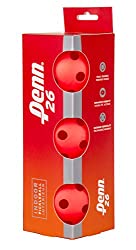
When choosing a pickleball ball, make sure you grab the right kind depending on if you’re playing indoor or outdoor. Indoor balls are softer, play slower and have 26 holes drilled in them. They will NOT work for outdoor play.
Outdoor balls have 40 hols drilled in them and are thicker and play faster. Outdoor pickleballs tend to not last as long because of the weather and will crack or break in three months of regular use.
Despite being wiffle balls, pickleballs are made from a different material than standard wiffle balls.
For indoor use, I recommend this ball from Penn, a big tennis manufacturer.
For outdoor use, I recommend the Franklin X 40.
Pickleball Fun Fact: Outdoor pickleball balls, despite being heavier, actually are slightly smaller than indoor balls. You’d never know until you see them next to each other.
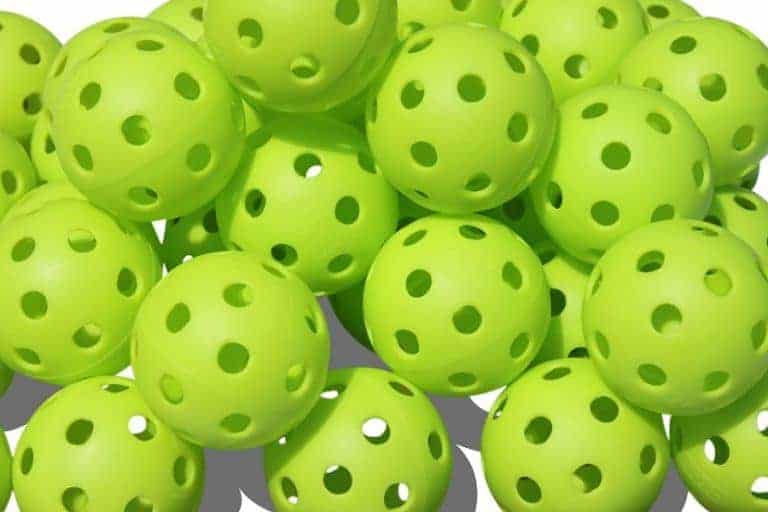
Pickleball Shoes
The single most important piece of equipment that plays the biggest role in preventing pickleball injuries is a good pair of court shoes. Do NOT step onto the court with a pair of running shoes or cross-trainers.
Why?
Because the tread on a running shoe is designed for vertical movement only. Running shoes have no lateral movement carved into their sole. So, you’re more likely to role an ankle or tear an achilles heel when playing pickleball in running shoes.
Trust me, don’t do it.
Instead, invest in a simple pair of court shoes. A shoe designed for tennis will also work for pickleball just the same.
I love my K-Swiss pickleball shoes. They’re light, fairly durable and relatively cheap. Another popular shoe is the New Balance 806.
And both of these pairs of shoes come in a mens and womens version.
How To Find A Place To Play Pickleball
The easiest place to pack up and go play some friendly pickleball is your nearest tennis court. Chances are, the closest park has a tennis court that has pickleball court lines on it; making the court dual-functional.
Other common places to play pickleball are rec centers, retirement communities or local churches.
But the best place to start is your nearest park with tennis courts. Call them up and ask if they’ve got pickleball courts. Chances are good, they’ve got a few courts with pickleball lines laid down on the tennis court.
If you’re lucky, the park may even have a stand-alone pickleball court next to the tennis courts.
The USAPA has invested in an easy way to plug in where you live and it’ll spit out all the local spots near your location. Just click on places2play.org and type in your city or zip code! It’s easy!
This may not show the nearest park with pickleball lines painted on the tennis court but it’s a great place to start.
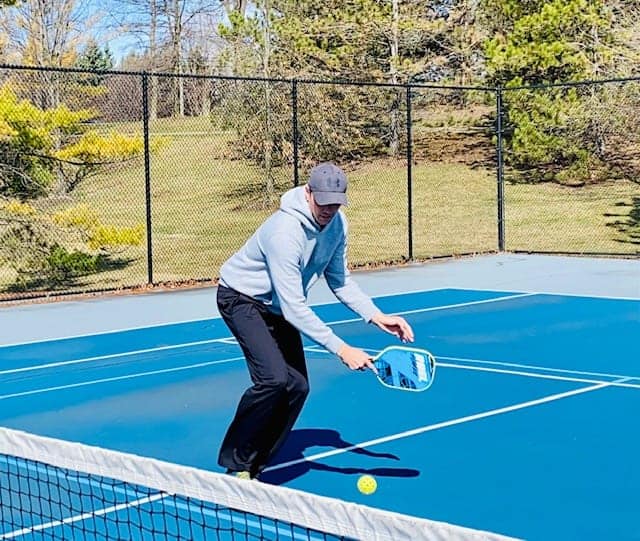
Pickleball History And How It Got Its Name
Pickleball is over 50 years old and was born on “The Rock”. The Rock is Bainbridge Island Washington in 1965.
Four families, the Pritchards, the Browns, the McCallums and the Bells are credited for creating the game when the four families were vacationing on the island.
Legend has it that on one grey afternoon, their kids were whining and moaning that there was nothing to do.
The kids were bored.
So Joel Pritchard did what any good parent would do. He told them to go out back on his property and mess around with the old, rundown badminton court.
He said “Go grab some ping pong paddles, a wiffle ball and hit the ball to each other.”
Literally just days later, the parents had gotten involved, started formulating rules and finding common ground (and arguing) about how the game should be played and scored.
The seeds of pickleball had been planted. And over the next three years they’d grow like a weed!
How the game got its name is a bit of conundrum or controversy. There are two competing theories behind the game’s whacky name.
While most think the game got its name from the Pritchard’s family dog named “Pickles” who would chase the ball, the more accurate but stranger story comes from rowing. Yes crew.
Joel Pritchard’s wife Joan, a big fan of rowing, was heard by her son telling her husband Joel and his friend Bill Bell how the game reminded her of the “pickleboat” that raced in crew.
The pickleboat is comprised of various non-varsity leftover rowers from various groups that created a hodgepodge rowing team with various skill levels.
Pickleball, because it borrowed random elements from so many different paddle sports, reminded Joan of the pickleboat.
So the name pickle-ball, instead of pickle-boat, was born.
Nowadays, it’s known simply as pickleball.
Click here for an in-depth article on why we have two completely different name origin stories and the controversy behind them.
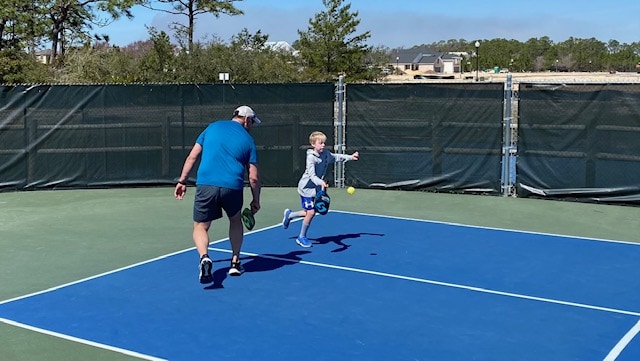
Is Pickleball Easier Than Tennis?
Pickleball is generally considered easier than tennis because it’s played on a shorter court but its mechanics and swing fundamentals also take less time to learn and perfect; even for someone with no racket sport background.
Pickleball also has strict serving rules that require all serves to be done underhand. For someone who’s not played either pickleball or tennis, this is actually a good thing.
Serving underhand is easier to perform than an overhead tennis smash serve.
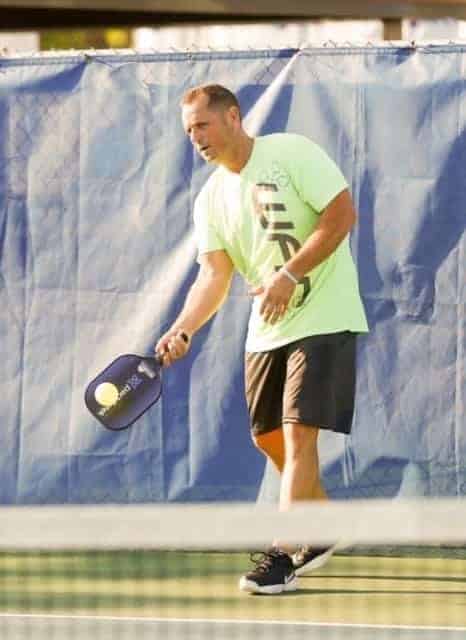
Pickleball also doesn’t require as much arm, shoulder and back strength as tennis. It also doesn’t demand as much calculated shot technique like tennis does with top spin and backspin cutting shots.
Don’t get me wrong, those shots can work in pickleball but aren’t necessarily as lethal in pickleball. Sometimes the best shot in pickleball is one that just dribbles over the net with no fancy spin.
Pickleball is also easier than ping pong in some respects because the ball is bigger and the paddles are larger and more forgiving. Not to mention, the emphasis on extreme spin that ping pong requires just isn’t as prevalent in pickleball.
Sure, top spin and backhand cuts work in pickleball but the need to perfect those types of shots just isn’t as demanding in pickleball compared to tennis and ping pong. Especially if you’re playing more casually or recreationally.
But all this activity doesn’t necessarily mean pickleball is any easier on the body.
Is pickleball good exercise? Yes, absolutely! Retired folks from Florida and Arizona (where the Pickleball Championships are often held) began to play pickleball as a means to stay active and fit.
Is Pickleball Easier On Your Knees Or Joints Than Tennis?
Just because pickleball is played on a smaller court doesn’t necessarily mean it’s any easier on your knees or joints. In fact, pickleball related injuries are on the rise and have been for quite some time.
Some doctors and coaches will tell you that now that pickleball is becoming a sport more and more younger players are enjoying, it’s starting to take a toll on their bodies too.
Here’s what one full-time coach told me.
He told me that, even though he’s a 5.0 level pro and full-time coach, he doesn’t compete in national tournaments anymore because at that level, with all the stop and go, “quick-twitch” movement placed on ankles, achilles heels and knees; it can wear out even a young body after 2-3 years.
This coach was 30 years old and in great shape.
But you’ve got to take into account the context of the level of play here.
We’re talking national tournaments played by 5.0 level players. The ball is going to be moving a lot faster at that level and the lateral demand placed on your knees is incredible. Compete at that level 12 times a year, for 5 years and you’re going to do some damage to any body type regardless of age.
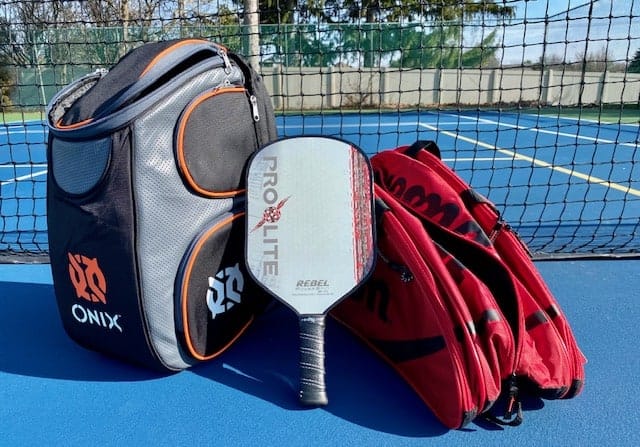
But you and I are not competing at that level, so do we really have anything to worry about?
To be honest with you, yes. We all do. The lateral, side to side movement required in even a slightly competitive game of pickleball can lead to injuries.
It is essential to warm up properly, stretch and always wear a good pair of court shoes for pickleball in order to prevent injury.
Going in cold to a competitive game of pickleball has led to torn ACLs, MCLs and torn achilles. Especially in older players that may not know their physical limitations.
So, always warm up and stretch before even the most modest or friendly of games.
What Is Pickleball – Conclusion
At its core, for someone who’s never played it, Pickleball is:
-Is an addictive paddle sport over 50 years old
-Borrows concepts from tennis and ping pong
-Is played on a court similar to a badminton court
-Can be played outdoors or indoors
-Is played with a paddle and special wiffle ball
-Loved by older and younger players alike
-Designed to be inclusive and accommodate all skill levels
At its core, pickleball is a socially friendly inclusive sport that resembles tennis, borrows bits from ping pong and is played on a court the same size as badminton.
Pickleball, although its growth and popularity is still on the rise, is actually over 50 years old and played by young players and older players. Its design and rule implementation are set up so that pure athleticism and age do not result in an extreme advantage.
Pickleball is a game of touch and is about ball placement just as much as it is about topspin forehands and passing shots.
In the end, pickleball is an inclusive sport that bring people together regardless of age, gender, racket sport background and skill level.
Check your local tennis court, I’ll bet you that it has pickleball court lines on it. Get yourself a paddle and a ball, a few friends and give it a try. Before long, you’ll be hooked. Trust me.

Welcome to TheVolleyLlama.com. My name is Keith, I’m just a lover of all sports that involve a racquet, net and a ball. I played competitive high school varsity tennis, love racquetball and my whole family plays pickleball regularly. I started this website to help give people like you the basics to learn these wonderful games.

